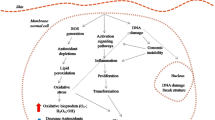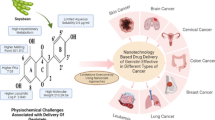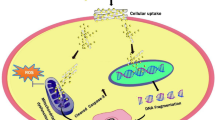Abstract
Nowadays, nanotubes are used widely as container agents to transport bioactive peptides, proteins, nucleic acids, and drugs, and used to deliver their cargos to cells and organs in human bodies. In this work, the possibility of the formation of stable composite between carbon nanotubes and skin anti-cancer drugs has been investigated. The nanotube used in this study includes 60 C atoms of (6,6) type. Density functional theory-based methods (B3LYP/6-31G) show that the composites between drugs (aminolevulinic acid and tretinoin) and nanotube are more stable than the single agents. The difference in the hybridization of C and O atoms can cause to a difference between bond lengths, angles, and charges. The natural bond orbital calculations indicate that some donor atoms (lone pair of oxygen or nitrogen atoms) can transfer electron to acceptor atoms (σ * or π * in carbon nanotube) and the occupancy of the oxygen lone pair with increasing p orbital share of the lone pair electrons of oxygen decreases. Then, the highest occupied molecular orbital (HOMO) and the lowest unoccupied molecular orbital (LUMO), the HOMO-LUMO bandgap, and the electronic chemical potential (μ) for the lowest energy derived to estimate the structural stability of the composites have been investigated. Results show that nanotube-tretinoin is more stable than nanotube - aminolevulinic acid.
Similar content being viewed by others
Avoid common mistakes on your manuscript.
Background
Skin cancer is the most common form of human cancer. It is estimated that over one million new cases occur annually. The annual rates of all forms of skin cancer are increasing each year, representing a growing public concern. As a result, many drugs have been developed to treat skin cancer. The available anti-cancer drugs have distinct mechanisms of action which may vary in their effect on different types of normal and cancer cells. In addition, there are very few demonstrable biochemical differences between cancerous cells and normal cells. For this reason, the effectiveness of many anti-cancer drugs is limited by their toxicity to normal rapidly growing cells in the intestinal and bone marrow areas. A final problem is that cancerous cells which are initially suppressed using a specific drug may develop a resistance to that drug. For this reason, cancer treatments may consist of using several drugs in combination for varying lengths of time [1–3]. The anti-cancer drugs that were selected in this work are tretinoin and aminolevulinic acid.
Tretinoin, or all-trans-retinoic acid, is a naturally occurring derivative of vitamin A (retinol). Retinoids such as tretinoin are important regulators of cell reproduction, proliferation, and differentiation and are used to treat acne and photodamaged skin and to manage keratinization disorders such as ichthyosis and keratosis follicularis.
Topical administration of tretinoin has proved to be effective in treating the clinical signs of photodamaged skin. Tretinoin, a natural vitamin A metabolite, is an anti-cancer drug used in the treatment of acute promyelocytic leukemia. It is more commonly used to treat skin disorders such as acne, warts, hyperpigmentation, and reactions to sunlight [4–6]. The other drug is aminolevulinic acid (4-oxopentanoic acid) which is to be used in photodynamic therapy to treat a skin condition called actinic keratosis [7].
The interesting properties of nanotubes have caused researchers and companies to consider using them in several fields, because carbon nanotubes have the highest strength to weight ratio of any known material [8, 9]. The highly regular atomic structure of carbon nanotubes (CNTs) and the large degree of the structure purity make it accessible to accurate computer modeling by a variety of theoretical techniques. CNTs have emerged as a new alternative and efficient tool for transporting and translocating therapeutic molecules [10, 11]. It is well recognized that the transport and bioavailability of drugs are significant factors in improving their distribution, therapeutics, selectivity, and in ameliorating their toxic effects [12–14]. Single-wall carbon nanotubes (SWNTs) with very high specific surface areas can be easily derivatized with biomolecules either through chemical attachment, adsorption, or encapsulation. Such bioconjugates on SWNTs have the ability to deliver bioactive molecules across cell membranes and even into the cell nuclei [15, 16]. Scientists have shown that nanotubes can release drugs in cells without damaging the healthy cells of the tissue. The advantages of using a carbon nanotube-assisted drug delivery system include efficient targeting and amplification of tumor targeting due to an enhanced permeability and retention effect of the carbon nanotube which can be efficiently loaded with the drug. The use of a non-toxic drug which is activated to its cytotoxic form in the tumor cells helps preserve the non-targeted normal tissue of the patient, thereby potentially reducing the side effects resulting from the therapy [17–19].
In this present work, the interactions between carbon nanotubes and the composites of these drugs with nanotube (1, nanotube - aminolevulinic acid; 2, nanotube - tretinoin) based on the density functional theory (DFT) methods and natural bond orbital (NBO) analysis have been investigated.
DFT, in particular, the exchange-correlation B3LYP hybrid density functional, is widely used in molecular modeling studies to predict structure, spectroscopic parameters, and energy changes of small-, middle-, and large-size molecules [20, 21].
Finally, the lowering highest occupied molecular orbital-lowest unoccupied molecular orbital (HOMO-LUMO) energy gaps have also been discussed.
Results and discussion
The hybrid values, Mulliken charges, bond lengths, and angles are shown in Table 1.
The results show that by increasing the p orbital share in the hybridization, the bond length increases. So, this hybrid can affect the bond angle, too. The Mulliken charges for the oxygen atoms in each compound are presented. The charge on the N in nanotube - tretinoin is smaller than that of nanotube - aminolevulinic acid. Therefore, the interaction in nanotube - tretinoin is stronger than that of nanotube - aminolevulinic acid that causes large negative charge on it (Table 2).
From the optimized structures, the relative and formation energies, the HOMO-LUMO bandgap as differences between the HOMO and LUMO, and the electronic chemical potential (μ) as half of the energy of the HOMO and LUMO have been found as a measure of the structural stability properties. Table 2 indicates that the energy values obtained are negative, signifying that such functionalization is of favorable stability. These parameters indicate that nanotube - tretinoin is more stable than nanotube - aminolevulinic acid and both of them are more stable than the single agents. Energy data show that the electron correlation increases the relative energy of less stable composite. The nanotube - tretinoin has the lowest HOMO-LUMO bandgaps; therefore, they confirm the stability of this compound.
As can be observed in Table 3, the composites between drugs and nanotube are more stable than other drugs.
The delocalization of electron density between the filled Lewis-type NBOs and empty anti-bonding non-Lewis NBOs leads to the loss of occupancy from the localized NBOs of the idealized Lewis structure into the empty non-Lewis orbitals. For each donor NBO and acceptor NBO, the stabilization energy is presented as the second-order perturbation interaction energy (E2) [27, 28]. The E2 energy values confirm the stability of nanotube - tretinoin, too.
These results show that the hyperconjugation between the lone pair orbitals of oxygen as donors and some σ * or π * orbitals as acceptors can occur. The most important common interaction in the nanotube -tretinoin composite is LP(2)O → π * C37 to C43 and in the nanotube - aminolevulinic acid composite is LP(2)O → π * C47 to C53. Tretinoin has the highest energy and can make the structure more stable than the other drug. Also, the occupancy decreases with increasing thep orbital share of the lone pair electrons of oxygen.
Conclusions
Based on the B3LYP/6-31G-optimized ground-state geometries, the NBO analysis of composites has demonstrated a charge transfer and effective energy interaction between the oxygen lone pair (LPO) and the anti-bonding orbitals (σ * or π *). As can be observed, the most important common interaction is LPO → π * C37 to C43 for nanotube - tretinoin. This factor provides more stability in this drug. Also, the NBO analysis show that by an increase of thep orbital share, the occupancy of the LPO decreases.
To justify the structural stability of composites, the HOMO-LUMO bandgap, the electronic chemical potential (μ), the second-order perturbation energy E2, the Mulliken charges, and the occupancy have been found as a measure of the structural stability properties for the purpose.
Results indicate that nanotube - tretinoin has higher E2 and μ energies and lower HOMO-LUMO gap and Mulliken charge. Therefore, this composite is more stable than nanotube- aminolevulinic acid, and both of them are more stable than the single drug.
Methods
Computational method
All of the calculations were carried out using a personal computer which has an Intel® Pentium® dual CPU with 2-GB RAM (Intel®, Santa Clara, CA, USA). At first, a nanotube including 60 C atoms (6,6) is formed using a nanotube modeler package [22]. Then, this nanotube is optimized using GaussView [23] and Gaussian 03 [24] softwares(Gaussian Inc., Wroclaw, Poland) by DFT/B3LYP method and 6-31G basis set (Figure 1). The selected drugs (aminolevulinic acid and tretinoin) were made using GaussView and optimized using Gaussian 03 by B3LYP functional with the basis set 6-31G (Figures 2 and 3) [25]. Then, the composites between nanotube and drugs were formed and optimized by B3LYP/6-31G method (Figures 4 and 5). Molecule hybridizations, bond angles, Mulliken charges, and bond lengths were calculated. The delocalization of electron density between the filled lone pair of Lewis-type NBOs and empty anti-bonding non-Lewis NBOs was obtained by NBO analyzing at B3LYP/6-31G level [26].
References
Lin J, Eder M, Weinmann S: Behavioral counseling to prevent skin cancer: a systematic review for the U.S. Preventive Services Task Force. Ann. Intern. Med 2011, 154: 190–201. 10.7326/0003-4819-154-3-201102010-00009
Narayanan D, Saladi R, Fox J: Ultraviolet radiation and skin cancer. Int. J. Dermatol. 2010, 49: 978–986. 10.1111/j.1365-4632.2010.04474.x
Sersa G, Miklavcic D, Cemazar M, Rudolf Z, Pucihar G, Snoj M: Electrochemotherapy in treatment of tumours. Eur. J. Surg. Oncol. 2008, 34: 232–240. 10.1016/j.ejso.2007.05.016
Joensuu H: Systemic chemotherapy for cancer: from weapon to treatment. Lancet Oncol 2008, 9: 304. 10.1016/S1470-2045(08)70075-5
Sanz M: Treatment of acute promyelocytic leukemia. Hematol. Am. Soc. Hematol. Educ. Progr 2006, 147–155.
Loureiro K, Kao K, Jones K, Alvarado S, Chavez C, Dick L, Felix R, Johnson D, Chambers C: Minor malformations characteristic of the retinoic acid embryopathy and other birth outcomes in children of women exposed to topical tretinoin during early pregnancy. Am. J. Med. Genet. A 2005, 136: 117–121.
Stummer W, Pichlmeier U, Meinel T, Wiestler OD, Zanella F, Reulen HJ: Fluorescence-guided surgery with 5-aminolevulinic acid for resection of malignant glioma: a randomised controlled multicentre phase III trial. Lancet Oncol. 2006, 7: 392–401. 10.1016/S1470-2045(06)70665-9
Liang Zang J, Yuan Q, Chao Wang F, Pu Zhao Y: A comparative study of Young's modulus of single-walled carbon nanotube. Comput.Mater. Sci 2009, 46: 621–625. 10.1016/j.commatsci.2009.04.007
Favila A, Gallo M, Glossman-Mitnik D: DFT studies of functionalized carbon nanotubes and fullerenes as nanovectors for drug delivery of antitubercular compounds. J. Mol. Mod. 2007, 13: 505. 10.1007/s00894-007-0170-2
Maiti A: Adsorption of carbon monoxide on a (6,6) armchair carbon nanotube: Ab initio study. Microelec.J 2006. Article in press Article in press
Tserpesa KI, Papanikos P: Finite element modeling of single-walled carbon nanotubes. Composites B 2005, 36: 468–477. 10.1016/j.compositesb.2004.10.003
Kostarelos K, Bianco A, Prato M: Promises, facts and challenges for carbon nanotubes in imaging and therapeutic. Nature 2007, 2: 108.
Bottini M, Cerignoli F, Dawson MI, Magrini A, Rosato N, Mustelin T: Noncovalentlysilylated carbon nanotubes decorated with quantum dots. Biomacromolecules 2006, 7: 2259–2263. 10.1021/bm0602031
Nakayama-Ratchford N, Bangsaruntip S, Sun X, Welsher K, Dai H: DNA wrapping and cleavage of a carbon nanotube–polypseudorotaxane conjugate. J. Am. Chem. Soc. 2007, 129: 2448–2449. 10.1021/ja068684j
Bianco A, Kostarelos K, Prato M: Opportunities and challenges of carbon-based nanomaterials for cancer therapy. Expert Opin. Drug Deliv. 2008, 5: 331–342. 10.1517/17425247.5.3.331
Kam NWS, Liu Z, Dai HJ: Functionalization of carbon nanotubes via cleavable disulfide bonds for efficient intracellular delivery of siRNA and potent gene silencing. Am. Chem. Soc. 2005, 127: 6021–6026. 10.1021/ja050062v
Reed AE, Curtiss LA, Weinhold F: Intermolecular interactions from a natural bond orbital, donor-acceptor viewpoint. J. Chem. Rev. 1988, 88: 899–926. 10.1021/cr00088a005
Yunpeng Y, Xiaoyuan C: Integrin targeting for tumor optical imaging. Theranostics 2011, 1: 102–126.
Zhuang L, Tabakman S, Welsher K: Carbon nanotube in biology and medicine. Nano Res. 2009, 2: 85–120. 10.1007/s12274-009-9009-8
Wongchoosuk C, Udomvech A, Kerdcharoen T: The geometrical and electronic structures of open-end fully functionalized single-walled carbon nanotubes. J. Curr. Appl. Phys 2009, 9: 352–358. 10.1016/j.cap.2008.03.003
Chelmecka E, Pasterny K, Kupka T, Stobinski L: Density functional theory studies of OH-modified open ended single wall zigzag carbon nanotube (SWCNTs). J. Mol. Struct. (THEOCHEM) 2010, 948: 93–98. 10.1016/j.theochem.2010.02.026
Fernandez L, Viruela-Martin P, Latorre J, Guillem C, Baltran A, Amoros P: Molecular precursors of mesostructured silica materials in the atrane route: A DFT/GIAO/NBO theoretical study. J. THEOCHEM. 2007, 822: 89–102. 10.1016/j.theochem.2007.07.022
Zahedi E, Aghaie M, Zare K: Density functional study of NBO, NICS and 14N NQR parameters of 5-methylcytosine tautomers in the gas phase. J. Mol. Struct. (THEOCHEM) 2009, 905: 101–105. 10.1016/j.theochem.2009.03.017
Frisch MJ, Trucks GW, Schlegel HB, Scuseria GE, Robb MA, Cheeseman JR, Montgomery JA Jr, Vreven T, Kudin KN, Burant JC, Millam JM, Iyengar SS, Tomasi J, Barone V, Mennucci B, Cossi M, Scalmani G, Rega N, Petersson GA, Nakatsuji H, Hada M, Ehara M, Toyota K, Fukuda R, Hasegawa J, Ishida M, Nakajima T, Honda Y, Kitao O, Nakai H: Gaussian 03, Revision C. 02. Wallingford, CT: Gaussian Inc; 2004.
Becke AD: A new mixing of Hartree-Fock and local density-functional theories. J. Chem. Phys. 1993, 98: 1372–1377. 10.1063/1.464304
Padmaja L, Amalanathan M, Ravikumar C, Hubert Joe I: Density functional theory calculations and vibrational spectral analysis of 3, 5-(dinitrobenzoic acid). Spectrochim. Acta 2009, A74: 349–356.
Roohi H, Ebrahimi A, Habibi SM, Jarahi E: NBO and AIM analyses of the anomeric effect in fluoromethanthiol. J. Mol. Struct. (THEOCHEM) 2006, 772: 65–73. 10.1016/j.theochem.2006.06.019
Nori-shargh D, Roohi F, Deyhimi F, Naeem-Abyaneh R: Conformational behaviors of trans-2,3-bis(methylthio)-1,4-dioxane, -dithiane and -diselenane. A hybrid-DFT study and NBO interpretations. J. Mol. Struct. (THEOCHEM) 2006, 763: 21–28. 10.1016/j.theochem.2006.01.011
Acknowledgements
The authors would like to thank the financial support by Islamic Azad University, Rasht, Iran.
Author information
Authors and Affiliations
Corresponding author
Additional information
Competing interests
The authors declare that they have no competing interests.
Authors’ contributions
Both authors participated in writing the manuscript. Both authors read and approved the final manuscript.
Authors’ original submitted files for images
Below are the links to the authors’ original submitted files for images.
Rights and permissions
Open Access This article is distributed under the terms of the Creative Commons Attribution 2.0 International License (https://creativecommons.org/licenses/by/2.0), which permits unrestricted use, distribution, and reproduction in any medium, provided the original work is properly cited.
About this article
Cite this article
Hesabi, M., Hesabi, M. The interaction between carbon nanotube and skin anti-cancer drugs: a DFT and NBO approach. J Nanostruct Chem 3, 22 (2013). https://doi.org/10.1186/2193-8865-3-22
Received:
Accepted:
Published:
DOI: https://doi.org/10.1186/2193-8865-3-22









